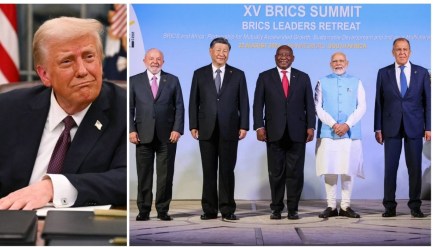As the BRICS nations convened in Rio de Janeiro for a two-day summit, US President Donald Trump reignited tensions with a fresh threat, any country aligning with what he called “Anti-American policies” of the bloc will face an additional 10% tariff, no exceptions.
The Trump administration released tariff letters on Monday detailing punitive tariff rates for 14 countries. Trump’s messaging has been blunt: partner with BRICS at the cost of American markets.
Trump’s warning also targeted the bloc’s push to de-dollarize global trade. “We require a commitment from these countries that they will neither create a new BRICS currency nor back any other currency to replace the mighty U.S. dollar,” Trump said earlier this year, adding that failure to comply would result in “100% tariffs.”
BRICS pushes back
Without naming the US, the BRICS bloc issued a joint statement at the summit raising “serious concerns” over rising tariffs, saying the measures violate World Trade Organization rules. The group warned that the new trade barriers “threaten to reduce global trade, disrupt supply chains, and introduce uncertainty into the global economy.”
Despite Trump’s claim that “BRICS is dead,” the group continues to expand. Originally made up of Brazil, Russia, India, China, and South Africa, the bloc has recently welcomed Egypt, Ethiopia, Iran, and the United Arab Emirates as new members. Indonesia, Thailand, and Vietnam have also joined as partner countries.
Growing cracks within BRICS
Still, signs of internal strain were visible at the Rio summit. Chinese President Xi Jinping pulled out citing “scheduling conflicts,” while Russian President Vladimir Putin participated only via video link. Analysts suggest that US trade pressure may be fracturing BRICS unity, especially among newer members who have stronger trade ties with Washington.
Despite these challenges, the bloc has reiterated that it is not seeking confrontation with the US. A South African diplomat at the summit said, “BRICS is not anti-U.S. We want a multipolar world, not an adversarial one.”
US trade threats loom large
Trump has spent months warning BRICS countries and others not to challenge the US dollar’s dominance. In January, he went so far as to claim that any BRICS member “mentioning the destruction of the dollar” would face a 150% tariff. “We don’t want your goods,” he said bluntly in a campaign rally earlier this year.
Despite his claims of victory, stating that BRICS was collapsing under US pressure, the group’s continued expansion and its cautious, diplomatic tone suggest that while Trump’s tariffs are rattling global alliances, they have not deterred the long-term vision of a more balanced global economic order.
